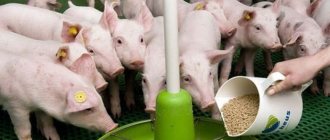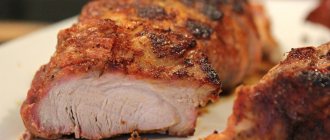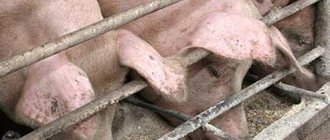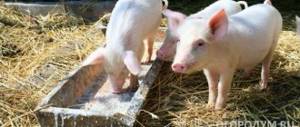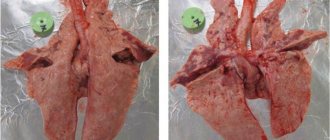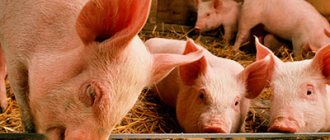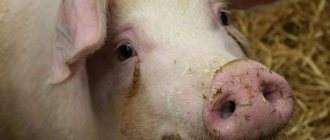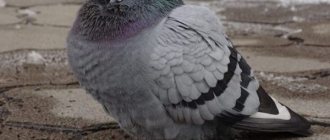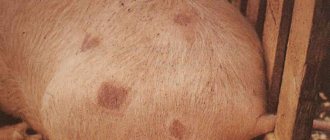Deep bedding for pigs is characterized by the laying of lactic acid and photosynthetic bacteria, thanks to which heat is retained for a long time. The use of fermentation material creates comfortable conditions, saves money (no additional heaters are required) and promotes waste absorption.
The essence and features of the technology
In simple terms, the functionality of deep litter is the same as that of a dry toilet - certain bacteria are placed in dry sawdust or other material. This technology has been used for many years in the USA, Asia and Europe, as it has a high level of profitability, which reduces costs on farms. The main principle of biolitter is a continuous chain of chemical reactions that cause fermentation.
Coprophagous bacteria are contained in special biological preparations. Their action is aimed at the following:
- elimination of unpleasant odors;
- heat generation - up to 40 degrees;
- neutralization of pathogenic microflora;
- strengthening the immune system of pigs;
- reducing the number of times the pigsty is cleaned;
- decomposition of animal waste;
- manure composting.
Deep litter is considered durable - it is used for 4 years. But the main condition for this is the constant presence of livestock animals in this room. Otherwise, the introduced bacteria die (the food source disappears).
After laying the materials, at least three days must pass for the bacteria to begin to act, and the layer thickness must be at least 50 cm, maximum 1 meter.
Advantages and disadvantages
Any innovative technology has its pros and cons. Deep litter has the following advantages:
- efficiency;
- ease of design creation;
- no need to install a ventilation system;
- wide range of applications - for large farms and private small livestock farming;
- the possibility of using scrap materials;
- increase in body weight of pigs (weight gain per day is 85 grams);
- there is no need to purify the air from ammonia vapor;
- durability;
- relatively low cost of biological products;
- the litter always remains dry;
- there is no need to remove manure (bacteria absorb it);
- purity of pigs;
- due to the high temperature of the litter, rodents and other pests do not breed;
- the possibility of using the resulting manure as an organic fertilizer.
An automatic hopper can be installed in the deep litter for feeding compound feed in the feed supply mode once a week. Thanks to this, feed is saved.
Among the disadvantages are the difficulties in cleaning the litter (although this must be done once every 4-5 years). This is due to the fact that the layer is too large.
Peculiarities
The fermentation litter consists of fermentative and photosynthetic harmless bacteria that allow the breakdown of animal waste . This operating principle can generally be compared with the operation of bio-toilets. All you need to do is cover the base layer and sprinkle it with beneficial bacteria. Voila - the pigsty is always clean, odorless, dry, warm and comfortable for the animals - a real find in pig farming!
Of course, those who hear about such material for the first time have more questions than answers. For example, how can bacteria break down manure? Does this affect the condition of the pigs? Let’s answer right away - the additive looks like ordinary sand or small shavings. There is nothing else special about it. The fermentation process occurs in deep layers, and not on the surface.
Operating principle
If you are worried about whether this bedding poses a threat to animals, then we can safely say that it does not. Many farmers and owners of not only pigs, but also other domestic animals can already confirm this. Its operating principle is based on a constant organic reaction. Due to the active action of bacteria, animal waste products instantly cause a fermentation process. As a result, there is no smell or waste itself, as stated in the video.
The fermentation process itself, that is, the breakdown of pig biological waste, occurs inside such nano-litter. The surface remains clean and dry. Moreover, due to the origin of the constant reaction, heat is generated. In the depths of the material, the temperature reaches about 40 degrees. However, on the surface it is about 20-30 degrees. This allows you to maintain an acceptable temperature in the room even in winter.
All the advantages:
- one thick covering layer is enough for about 4-5 years;
- significant savings in time and effort on cleaning a large pigsty;
- manure dissolves completely in the litter in about a day;
- no smell, no liquid, no dirty areas;
- reduces the need to heat animals;
- allows to reduce the incidence and mortality of piglets;
- living microorganisms displace pathogenic flora;
- such bedding in a pigsty is a safe and absolutely pure natural material;
- reduction of the workforce several times;
- prevention of many viral diseases in pigs (dysentery, E. coli, etc.);
- reducing the emission of harmful ammonia into the atmosphere and pollution of groundwater from manure.
Bacteria and their types
Bacteria for bedding in a pigsty greatly facilitate the work of livestock farmers . Moreover, they are absolutely safe for the pigs themselves. By breaking down waste products, they help keep the bioshed clean. These microscopic workers were obtained in scientific laboratories. According to the principle of operation, these single-celled organisms can be compared with yeast, only the former absorb not sugar, but urea and manure.
A participant of the GEOTEK TD channel will share her opinion about the domestic drug AgroBriz. Why she liked the warm fermentation mat - see below.
How to properly arrange deep litter?
To ensure that the deep litter functions properly, adhere to the following rules:
- eliminate drafts;
- provide the room with simple ventilation;
- do not lay the material on a concrete floor - it is better to use soil;
- minimum air temperature – 0 degrees;
- natural materials must be dry (this is the only way the biological product can be added to them);
- before laying the first layer, disinfection measures are carried out, dirt and old manure are always cleaned out;
- the temperature when creating the litter should be from +5 to +10 degrees;
- the first layer should be 20 cm, after which the drug is added (then the same amount of materials is laid, the drug is added again, etc.);
- The diet of pigs should be based on fiber (40-60%), since it is this substance that increases fermentation.
The biological layer must consist of natural materials. For this, straw from cereal crops, sawdust, hay and the like are used. You can use one of the materials or mix them in a free ratio. When the biomaterial stops working, an unpleasant odor appears, and the litter does not absorb moisture. A variety of preparations are used to create deep litter.
We also recommend that you read the detailed material on caring for pigs in this article: features of breeding pigs.
Barnyard
This product is popular among farmers. It is available in powder form. When installing a bedding layer, you must adhere to the following recommendations:
- To achieve a positive result, a soil floor is created, which should have a slight slope. If the pigsty has a concrete floor, then a grate is placed on it, through which the liquid will drain. The soil should be drained, for which you can add a little sand or sawdust.
- When laying materials, the temperature should be positive. Otherwise, bacteria will not multiply and act.
- The substance from the package is mixed with a dry substrate - flour, bran or sawdust. And only after that it scatters over the surface of the straw.
- To distribute the powder evenly, sift it through a sieve.
- As expected, a 20-30 cm layer of natural raw materials is initially poured, followed by the preparation.
- The pigs are immediately released.
- After a couple of days, it is necessary to add straw and the preparation again (layer up to 30 cm).
- To make bacteria work more actively, the drug is added once a month. This is especially important when the layers are heavily compacted.
- The minimum period of validity of the Animal Farm without additions is one and a half years. But this is provided that there is an organic basis. If the drug is added to a mixture of straw and sawdust, the service life increases.
Biolatic bedding bacteria
Another popular new generation drug that can be used on concrete surfaces. In this case, the layer should be 40-50 cm. If the litter layer is formed on the soil, then the height of the layer increases by 10-15 cm.
Rules:
- One head must be placed per square meter, that is, if there are 5 pigs in the pigsty, then the room must be at least 5 square meters. m.
- For active bacterial activity, it is recommended to add the drug to sawdust. If you combine them with straw, then the ratio of sawdust and other material should be 7:1.
- The humidity of the layer should not exceed 30%.
- There is a “wet start” technology, which is used when installing deep litter using the Biolatic drug. This involves combining a loose powdery substance with purified water that does not contain bleach. For 100 liters of water you will need 2 kg of the drug.
- Initially, a layer of sawdust 20 cm high is formed, after which the resulting solution is distributed. For uniform application, it is advisable to use a spray bottle.
- Next, another layer is created, but from manure or bran. The solution from the drug is distributed again.
- They release the animals.
- If there are many heads in one room, then the layer needs to be changed after 2-3 years, if there are few - after 4-5. That is, with fewer pigs in the pigsty, the duration of action of the drug increases.
- Feature - it is advisable to dig up the layer 1-2 times a week, which will allow bacteria to be evenly distributed throughout the room. If you do not dig, then you will have to introduce bacteria monthly.
- After the layer of sawdust has become very compacted and settled, it is necessary to apply the biological agent again, but in smaller quantities.
Netto-Plast
The most famous drug that is used most often. This product is universally applicable - ideal for soil, concrete, wood and other materials. That is, you can create flooring layers on any surface. Moreover, there is no need to change the old bedding layer, since enzymes can multiply on any substrate.
Among natural materials, it is advisable to give preference to sawdust and wood shavings. If a mixed type of litter is used, then you can add seeds, buckwheat husks, straw, etc. But the wood material should be 10-20% more than half. In this case, there is no need to measure the humidity in the room.
The process of arranging deep litter:
- Spread natural raw materials over the floor surface. Be sure to take into account the degree of shrinkage (usually 10-15 cm).
- Spread the powdered product as evenly as possible by hand.
- Dig with a shovel or pitchfork, which will speed up the fermentation process.
- Launch the pigs.
Features of using the drug Netto-plast:
- The minimum service life of bacteria is 3 years from the date of application. But for this you must follow all the rules.
- Antibacterial agents, as well as chemicals that destroy beneficial bacteria, are prevented from getting into the layers.
- Strictly monitor the uniform distribution of feces throughout the pigsty. If pigs defecate in only one area, you will have to use a shovel to move the excrement to other areas so that the bacteria act everywhere.
- It is advisable to create ventilation. To do this, the layers are periodically loosened. You can use a pitchfork.
- When compacting, additional wood shavings or sawdust are added. To prevent trampling of the litter, it is advisable to use large shavings.
Methods for keeping pigs and piglets on deep litter
This technology is relatively new in our country, but has already managed to gain a leading place. Deep flooring can be used in different ways, which is where its versatility is demonstrated.
Walking method
This is the most optimal option for using deep litter. Can be used for adults and piglets at any stage of development. But there is one rule that must be strictly adhered to - pigs of approximately the same age category must be in the same pen. This is due to the fact that for piglets it is enough to lay a layer of materials up to 40 cm, for older pigs - more.
The walking method involves setting up an open pen near the pigsty, where biologically active material is placed. Walking should be done daily, but the maximum break is 3 days. After the onset of cold weather, the bedding is transferred to the room where the pigs will be kept permanently.
Walk-free method
This technique is used in winter, when it is not possible to take pigs outside. This will increase the reproductive capacity of pigs and accelerate the growth of piglets.
This is achieved thanks to the created microclimate. In addition, the absence of high humidity develops animal resistance to diseases.
You can also watch the video, which explains useful tips for keeping pigs on deep litter:
Deep litter for pigs with bacteria
Deep litter for pigs is a special housing technology based on the principle of functioning of a biological toilet. Bacteria for special purposes are added to dry sawdust. Their main task is to absorb waste excreted by piglets. It is noteworthy that the bedding not only eliminates animal waste products, but also creates the warmth necessary for their comfortable living.
Keeping pigs using deep litter technology
Reviews
★★★★★
Anatoly, 46 years old. I have been using deep litter on my pig farm for about 6 years now.
Very convenient and profitable. So I gave up on the extra workers who were constantly cleaning the premises. After all, bacteria themselves absorb waste, processing it into organic matter. There is no unpleasant smell, the pigs are always clean, because the floor is dry. I changed the bedding after 4 and a half years. I scattered the waste material around my own garden and I will say that the yield that year was quite high. ★★★★★
Svetlana, 59 years old. I have been raising pigs for about 20 years. I usually have up to 10 of them.
Three years ago I read about deep litter and decided to try the technology. In principle, I am pleased with the result - dry, clean, no stink. But I want to draw your attention to one feature. I keep pigs in twos, but some pigs defecate only in one corner, so I have to periodically (once every 2-3 days) mix the biomaterial, that is, scatter the one with feces in other areas of the pigsty. Over the course of three years, I had already accumulated a layer of about 70-80 cm, so I decided to remove some humus and fill it with new material (I use straw and hay, Netto-plast). But I removed 40 centimeters, and left the lowest layer for fermentation. I don't know if I did the right thing or not. Hide
Add your review
Using deep bedding is a profitable activity that reduces costs, creates comfortable conditions for animals and allows you to save your own effort and time. The main rule for the successful use of biotechnology is to strictly follow the recommendations, requirements and dosages of the drugs.
1
0
Copy link
Keeping pigs on bacterial bedding
Keeping livestock on fermentation bedding is most similar to the free-range rearing method. The animals are in one common spacious room, move around it freely, independently choose places for dens, defecate, and feed freely.
One of the advantages of this method is that it increases the pigs’ resistance to stress. They may follow their natural inclinations and rummage in the litter. Pigs move a lot and actively, acquire good physical shape, a strong musculoskeletal system, and their immunity increases.
